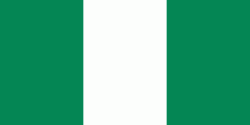Adamawa State (Adamawa State)
Of the 36 states in Nigeria, Adamawa state is the eighth largest in area, but the thirteenth least populous with an estimated popupation of about 4.25 million as of 2016. Geographically, the state is mainly composed of the highlands of mountains (the Atlantika, Mandara, and the Shebshi ranges) and the Adamawa Plateau, crossed by valleys and rivers, most notably the Benue and Gongola rivers. The lowlands of Adamawa are part of the West Sudanian savanna in the north and the wetter Guinean forest–savanna mosaic in parts of the south, while elevated areas are parts of the Mandara Plateau mosaic and Cameroonian Highlands forests ecoregions. In the extreme south of the state is part of the Gashaka Gumti National Park, a large wildlife park that contains large populations of bushbuck, African buffalo, patas monkey, black-and-white colobus, giant pangolin, and hippopotamus along with some of Nigeria's last remaining Nigeria-Cameroon chimpanzee, African leopard, and African golden cat populations.
What is now Adamawa state has been inhabited for years by various ethnic groups, including the Bwatiye (Bachama), Bali, Bata (Gbwata), Gudu, Mbula-Bwazza, and Nungurab (Lunguda) in the central region; the Kamwe in the north and central region; the Jibu in the far south; the Kilba, Marghi, Waga, and Wula in the north, and the Mumuye in the south, while the Fulani live throughout the state—often as nomadic herders. Adamawa state is also religiously diverse as about 35% of the population is Sunni Muslim and 40% is Christian (mainly Lutheran, EYN, ECWA, and Pentecostal), while the remaining 25% are adherents of traditional ethnic religions.
In the early 1800s, the Fulani jihad captured some of modern-day Adamawa state and formed the Adamawa Emirate under the Sokoto Caliphate. About 90 years later, forces from Germany and the British Empire defeated the Emirate in the Adamawa Wars and split the area. The British-controlled area (much of the west of modern-day Adamawa) was incorporated into the Northern Nigeria Protectorate, which later merged to constitute British Nigeria, before becoming an independent state-- Nigeria, in 1960. The German-controlled area formed a part of German Kamerun until allied forces invaded and occupied Kamerun during the Kamerun campaign of World War I. After the war, what is now eastern Adamawa state became most of the Northern Cameroons within the British Cameroons, until 1961, when a referendum led to itsmerger with Nigeria. Originally, modern-day Adamawa State was a part of the post-independence Northern Region until 1967 when the region was split and the area became part of the North-Eastern State. After the North-Eastern state was split in 1976, Gongola State was formed on 3 February 1976 alongside ten other states. Fifteen years after statehood, Gongola was split with the state's south becoming Taraba State while its north became Adamawa State.
As an agriculturally-based state, the Adamawa State economy mainly relies on livestock and crops, such as cotton, groundnuts, millet, cassava, guinea corn, and yams. After years of the Boko Haram insurgency affecting development in the state, Adamawa has the eleventh lowest Human Development Index in the country but as the insurgency has abated since 2016, development has renewed.
Adamawa is one of the largest states of Nigeria and occupies about 36,917 square kilometers. It is bordered by the states of Borno to the northwest, Gombe to the west and Taraba to the southwest. Its eastern border forms the national eastern border with Cameroon.
Topographically, it is a mountainous land crossed by the large river valleys – Benue, Gongola and Yedsarem. The valleys of the Mount Cameroon, Mandara Mountains and Adamawa Plateau form part of the landscape.
Map - Adamawa State (Adamawa State)
Map
Country - Nigeria
 |
 |
| Flag of Nigeria | |
Nigeria has been home to several indigenous pre-colonial states and kingdoms since the second millennium BC, with the Nok civilization in the 15th century BC, marking the first internal unification in the country. The modern state originated with British colonialization in the 19th century, taking its present territorial shape with the merging of the Southern Nigeria Protectorate and Northern Nigeria Protectorate in 1914 by Lord Lugard. The British set up administrative and legal structures while practising indirect rule through traditional chiefdoms in the Nigeria region. Nigeria became a formally independent federation on 1 October 1960. It experienced a civil war from 1967 to 1970, followed by a succession of military dictatorships and democratically elected civilian governments until achieving a stable democracy in the 1999 presidential election. The 2015 general election was the first time an incumbent president failed to be re-elected.
Currency / Language
| ISO | Currency | Symbol | Significant figures |
|---|---|---|---|
| NGN | Nigerian naira | ₦ | 2 |
| ISO | Language |
|---|---|
| EN | English language |
| HA | Hausa language |
| IG | Igbo language |
| YO | Yoruba language |















